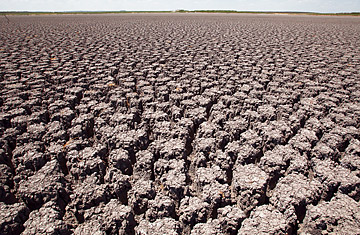
The Texas drought, which dried up San Angelo's O.C. Fisher Lake, shown on Aug. 3, 2011, is one of the most severe on record for the state
(2 of 2)
Thanks to campaigns and the realities of Texas gardening, xeriscaping has become more popular, but lawns remain ubiquitous and many municipal water systems are seeing usage increase. Plano, a modern suburb near Dallas, collected $3 million in additional revenue this year, according to the Dallas Morning News. A small part of that flow feeds garden ponds and birdbaths, and one bonus of the drought has been the abundance of wildlife drawn to urban gardens in search of water.
The state's large cities, while urging conservation, face no imminent shortages. But the heat is stressing old infrastructure. In the small town of Kemp, southeast of Dallas, cracked land caused pipes to shift and burst, releasing 2 million gal. of water to leach into the thirsty soil. Residents were without water for 48 hours.
Drought for the city dweller may mean inconvenience, but for Texas' rural residents it has been devastating. The drought of 2011 may be the costliest in Texas history for agriculture and may have repercussions well beyond the state's borders, Mark Welch, an economist with the Texas AgriLife Extension Service, told the Jacksonville Daily Progress in East Texas. "It's a 3, 4, 5 billion-dollar impact right now, just in Texas," Welch said. "This is a big deal."
The full cost of the drought, of course, won't be known until it's over, and the end is not in sight right now, says Ray Perryman, head of the Perryman Group, an economic- and financial-research company based in Waco. The most costly drought, so far, was in 2006 and caused $4.6 billion in direct agricultural losses. "This one is likely to be much worse," Perryman says. "First, it appears it will be longer, hotter and drier. And second, commodity prices are higher this time." Perryman estimates the direct losses could range from $7 billion to $8 billion with overall effects totaling $120 billion in Texas' $1 trillion annual economy.
All five of the state's major crops — wheat, corn, hay, sorghum and cotton — have suffered huge losses. Welch said the annual wheat yield has been cut in half and since most of that is exported overseas, the reduction will have profound effects on world markets in which prices are already high. While urban gardeners have watched their vegetable patches go into shutdown earlier than normal, the triple-digit temperatures have stalled major farm operations, and that is having a ripple effect on small-town economics.
In West Texas, the headlines are much the same. Cotton crops are down to 3.5 million bales from 5 million last year, according to the Lubbock Avalanche-Journal, and agriculture economists are estimating the drought could cost farmers and ranchers twice the losses of 2006.
Meanwhile, in South Texas, where an oil and gas boom is fueling economic activity, energy companies may find themselves competing for water with local farmers. Because of the geological nature of the Eagle Ford formation, fracking there requires three or four times as much water as needed in other parts of the state, according to Bloomberg News. Energy companies are using recycled fracking fluids and laying down limestone roads to cut down on dust from the normal dirt roads used in the fields. But demand is expected to rise tenfold in the next decade, according to the Texas Water Development Board, and without a recharge to the area reservoirs, oilmen may find themselves competing for water with farmers of sugar cane, melon, pepper and cotton.
In the past, Texas has done a "reasonable" job of water-resources planning, using a series of 50-year plans. But the shale formations that are attracting new oil discoveries do pose unique challenges, Perryman says. They generate enormous economic benefits, but the hydraulic fracturing techniques are water-intensive and have not been factored into long-range plans and are not reflected in historical usage data, Perryman adds. "The combination of that incremental demand with the extreme drought condition is posing some notable challenges that will require careful management, particularly if the drought persists."
For now, all eyes are on the tropical waters off West Africa, hoping to see some swirl of stormy weather that may head Texas' way. No one wants a Hurricane Katrina or a Rita, of course, but everyone hopes for a long soak from a slow-moving, less furious tropical storm, something that will heal the cracked land and fill the reservoirs across the state. Until then, it is best to just stay inside and watch as the birds dip into the birdbath for a meager beakful of water, and ponder how a squirrel who has splayed himself on a persimmon branch feels about the triple-digit doldrums.
